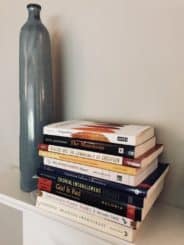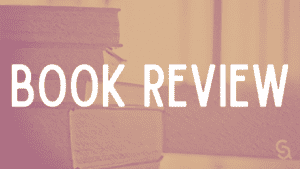
Originally published on November 26, 2019
I’m constantly asked for resources on how people can move forward learning about Indigenous culture, and I’m often repeating the same thing: read books.
Read books.
First and foremost, this supports Indigenous peoples who are writers and creators. It directly gives back to Indigenous communities and reminds the reader that Indigenous peoples are still here, creating new content for the world.
It’s also important to have this conversation for well-meaning allies. Indigenous peoples cannot do the work for you. You must dig in and learn yourself, and the best way to do that is to lean into our cultures. Learn about us. Do your research, and then we can have a conversation that isn’t a one-sided history or cultural lesson.
So I’ve compiled a list of 25 books, some that I’m reading now, some that I’ve already read, some that I can’t wait to get my hands on.
These are books by people of many different tribes. When asked by Christians who they should read by Indigenous theologians, this is my answer: read everything. Read books by people who are and aren’t Christians, because if you really want to know about and engage Indigenous cultures, you have to read from a variety of voices. If you want to break cycles of colonization and assimilation, you must take the time to learn from Indigenous experiences, through our own words.
If you want to break cycles of colonization and assimilation, you must take the time to learn from Indigenous experiences, through our own words.
To truly learn who we are means you engage with us on our terms.
Some of these books are fiction, some are non-fiction. A few are children’s books, and I encourage you to buy them whether you have children or not.
Spirituality is a thread throughout many of them because Indigenous culture is felt through our spirits, our ancestors, and the land. Some are books of poetry and prayers; some are strictly unpacking history.
I hope you find exactly what you need here, and please know that this is only a few of the many amazing books out in the world written by Indigenous peoples.
American Indian Liberation: A Theology of Sovereignty by George Tinker (Osage)
Why do Christian understandings of Jesus and God clash with American Indian worldviews? “Tink” Tinker of the Osage Nation describes the oppression suffered by American Indians since the arrival of European colonists, who brought a different worldview across the ocean and attempted to convert the native population to the religion they also imported.
Bowwow Powwow by Brenda J Child (Red Lake Ojibwe)
When Uncle and Windy Girl and Itchy Boy attend a powwow, Windy watches the dancers and listens to the singers. She eats tasty food and joins family and friends around the campfire. Later, Windy falls asleep under the stars. Now Uncle’s stories inspire other visions in her head: a bowwow powwow, where all the dancers are dogs. In these magical scenes, Windy sees veterans in a Grand Entry, a visiting drum group, traditional dancers, grass dancers, and jingle-dress dancers—all with telltale ears and paws and tails, all celebrating in song and dance, and all attesting to the wonder of the powwow.
Braiding Sweetgrass: Indigenous Wisdom, Scientific Knowledge and the Teachings of Plants by Robin Wall Kimmerer (Potawatomi Citizen Band)
Drawing on her life as an indigenous scientist and as a woman, Kimmerer shows how other living beings—asters and goldenrod, strawberries and squash, salamanders, algae, and sweetgrass—offer us gifts and lessons, even if we’ve forgotten how to hear their voices. In reflections that range from the creation of Turtle Island to the forces that threaten its flourishing today, she circles toward a central argument: that the awakening of ecological consciousness requires the acknowledgment and celebration of our reciprocal relationship with the rest of the living world. For only when we can hear the languages of other beings will we be capable of understanding the generosity of the earth, and learn to give our own gifts in return.
Colonial Entanglement: Constituting a Twenty-First-Century Osage Nation by Jean Dennison (Osage)
By situating the 2004-2006 Osage Nation reform process within its historical and current contexts, Dennison illustrates how the Osage have creatively responded to continuing assaults on their nationhood. A fascinating account of a nation in the midst of its own remaking, Colonial Entanglement presents a sharp analysis of how legacies of European invasion and settlement in North America continue to affect indigenous people’s views of selfhood and nationhood.
Drowning in Fire (Sun Tracks Series) by Craig Womack (Muscogee Creek-Cherokee)
Interweaving past and present, history and story, explicit realism and dreamlike visions, Craig Womack’s Drowning in Fire explores a young man’s journey to understand his cultural and sexual identity within a framework drawn from the community of his origins. A groundbreaking and provocative coming-of-age story, Drowning in Fire is a vividly realized novel by an impressive literary talent.
Embers: One Ojibway’s Meditations by Richard Wagamese (Ojibwe)
In this carefully curated selection of everyday reflections, Richard Wagamese finds lessons in both the mundane and sublime as he muses on the universe, drawing inspiration from working in the bush—sawing and cutting and stacking wood for winter, as well as the smudge ceremony to bring him closer to the Creator. Embers is perhaps Richard Wagamese’s most personal volume. Honest, evocative and articulate, he explores the various manifestations of grief, joy, recovery, beauty, gratitude, physicality and spirituality—concepts many find hard to express.
Glory Happening: Finding the Divine in Everyday Places by Kaitlin B. Curtice (Potawatomi Citizen Band)
Glory Happening is a book of stories and prayers that remind you to take a closer look at your everyday circumstances, to find the magical beauty in everyday experiences. It is an invitation to live deeply into every moment with the expectation that something good will find you at the end of the day. And once you experience glory, you have words to speak, a prayer to pray, and a story to tell. And so glory grows from person to person, and community is created around the reality that God is truly in our midst.
God is Red: A Native View of Religion by Vine Deloria, Jr. (Standing Rock Sioux)
God Is Red remains the seminal work on Native religious views, asking new questions about our species and our ultimate fate. Celebrating three decades in publication with a special 30th-anniversary edition.
Heart Berries by Terese Mailhot (Seabird Island Band)
Heart Berries is a powerful, poetic memoir of a woman’s coming of age on the Seabird Island Band in the Pacific Northwest. Having survived a profoundly dysfunctional upbringing only to find herself hospitalized and facing a dual diagnosis of post-traumatic stress disorder and bipolar II disorder; Terese Marie Mailhot is given a notebook and begins to write her way out of trauma.
I Am Woman: A Native Perspective on Sociology and Feminism by Lee Maracle (Stó:lo Nation of British Columbia)
As Maracle writes, “I Am Woman represents my personal struggle with womanhood, culture, traditional spiritual beliefs and political sovereignty, written during a time when that struggle was not over. My original intention was to empower Native women to take to heart their own personal struggle for Native feminist being. The changes made in this second edition of the text do not alter my original intention. It remains my attempt to present a Native woman’s sociological perspective on the impacts of colonialism on us, as women, and on my self personally.”
Long Powwow Nights by David Bouchard, Pam Aleekuk (Métis)
The Powwow is a time-honored Native American custom. It is a celebration of life and spirituality, a remembrance of traditions, uniting a people through dance and ritual. Long Powwow Nights takes you on a wonderful journey, honoring these mystical dancers who keep their traditions alive through dance and song. In its poetic verses, David Bouchard skillfully narrates the story of a mother’s dedication to her roots and her efforts to impress upon her child the importance of culture and identity.
The Manitous: The Spiritual World of the Ojibway by Basil Johnston (Ojibway)
Manitous lived in human form among the Ojibway in the early days, after Kitchi-Manitou (the Great Mystery) created all things and Muzzu-Kummik-Quae (Mother Earth) revealed the natural order of the world. With depth and humor, Johnston tells how lasting tradition was brought to the Ojibway by four half-human brothers, including Nana’b’oozoo, the beloved archetypal being who means well but often blunders. He also relates how people are helped and hindered by other entities, such as the manitous of the forests and meadows, personal manitous and totems, mermen and merwomen, Pauguk (the cursed Flying Skeleton), and the Weendigoes, famed and terrifying giant cannibals.
The Mishomis Book: The Voice of the Ojibway by Edward Benton-Banai (Wisconsin Ojibway)
Written for readers from all cultures—but especially for Ojibway and Native youth—The Mishomis Book provides an introduction to Ojibway culture and an understanding of the sacred Midewiwin teachings, aiming to protect this knowledge by instilling its importance in a new generation. Encouraging the preservation of a way of life that is centered on respect for all living things, these vibrant stories about life, self, community, and relationship to nature are just as relevant to the modern reader as they were hundreds of years ago.
Native American DNA: Tribal Belonging and the False Promise of Genetic Science by Kim Tallbear (Sisseton Wahpeton Oyate)
In Native American DNA, Kim TallBear shows how DNA testing is a powerful—and problematic—a scientific process that is useful in determining close biological relatives. But tribal membership is a legal category that has developed in dependence on certain social understandings and historical contexts, a set of concepts that entangles genetic information in a web of family relations, reservation histories, tribal rules, and government regulations. At a larger level, TallBear asserts, the “markers” that are identified and applied to specific groups such as Native American tribes bear the imprints of the cultural, racial, ethnic, national, and even tribal misinterpretations of the humans who study them.
One Church, Many Tribes by Richard Twiss (Sicangu Lakota Oyate)
In this captivating chronicle of the Native American story, Richard Twiss of the Rosebud Lakota/Sioux sifts through myth and legend to reveal God’s strategy for the nation’s host people.
Onigamiising: Seasons of an Ojibwe Year by Linda LeGarde Grover (Bois Forte Band of Ojibwe)
In fifty short essays, Grover reflects on the spiritual beliefs and everyday practices that carry the Ojibwe through the year and connect them to this northern land of rugged splendor. As the four seasons unfold—from Ziigwan (Spring) through Niibin and Dagwaagin to the silent, snowy promise of Biboon—the award-winning author writes eloquently of the landscape and the weather, work and play, ceremony and tradition and family ways, from the homey moments shared over meals to the celebrations that mark life’s great events.
Power: A Novel by Linda Hogan (Chickasaw)
When sixteen-year-old Omishto, a member of the Taiga Tribe, witnesses her Aunt Ama kill a panther—an animal considered to be a sacred ancestor of the Taiga people—she is suddenly torn between her loyalties to her Westernized mother, who wants her to reject the ways of the tribe, and to Ama and her traditional people, for whom the killing of the panther takes on grave importance.
The Round House: A Novel by Louise Erdrich (Turtle Mountain Band Chippewa)
The Round House is a page-turning masterpiece of literary fiction—at once a powerful coming-of-age story, a mystery, and a tender, moving novel of family, history, and culture.
Shalom and the Community of Creation by Randy Woodley (Keetoowah)
In Shalom and the Community of Creation Randy Woodley offers an answer: learn more about the Native American “Harmony Way,” a concept that closely parallels biblical shalom. Doing so can bring reconciliation between Euro-Westerners and indigenous peoples, a new connectedness with the Creator and creation, an end to imperial warfare, the ability to live in the moment, justice, restoration—and more biblically authentic spirituality. Rooted in redemptive correction, this book calls for true partnership through the co-creation of new theological systems that foster wholeness and peace.
There, There: A Novel by Tommy Orange (Cheyenne, Arapaho)
Here is a voice we have never heard—a voice full of poetry and rage, exploding onto the page with urgency and force. Tommy Orange has written a stunning novel that grapples with a complex and painful history, with an inheritance of beauty and profound spirituality, and with a plague of addiction, abuse, and suicide.
Trail of Lightning (The Sixth World Series) by Rebecca Roanhorse (Ohkay Owingeh)
Maggie Hoskie is a Dinétah monster hunter, a supernaturally gifted killer. When a small town needs help finding a missing girl, Maggie is their last best hope. But what Maggie uncovers about the monster is much more terrifying than anything she could imagine.
Two Old Women by Velma Wallis (Gwich’in Athabaskan)
Based on an Athabascan Indian legend passed along for many generations from mothers to daughters of the upper Yukon River Valley in Alaska, this is the suspenseful, shocking, ultimately inspirational tale of two old women abandoned by their tribe during a brutal winter famine. Though these women have been known to complain more than contribute, they now must either survive on their own or die trying. In simple but vivid detail, Velma Wallis depicts a landscape and way of life that are at once merciless and starkly beautiful. In her old women, she has created two heroines of steely determination whose story of betrayal, friendship, community, and forgiveness “speaks straight to the heart with clarity, sweetness, and wisdom” (Ursula K. Le Guin).
Whereas by Layli Long Soldier (Oglala Lakota)
Whereas confronts the coercive language of the United States government in its responses, treaties, and apologies to Native American peoples and tribes, and reflects that language in its officiousness and duplicity back on its perpetrators. Through a virtuosic array of short lyrics, prose poems, longer narrative sequences, resolutions, and disclaimers, Layli Long Soldier has created a brilliantly innovative text to examine histories, landscapes, her own writing, and her predicament inside national affiliations.
Why Indigenous Literatures Matter by Daniel Heath Justice (Cherokee Nation)
Part survey of the field of Indigenous literary studies, part cultural history, and part literary polemic, Why Indigenous Literatures Matter asserts the vital significance of literary expression to the political, creative, and intellectual efforts of Indigenous peoples today. In considering the connections between literature and lived experience, this book contemplates four key questions at the heart of Indigenous kinship traditions: How do we learn to be human? How do we become good relatives? How do we become good ancestors? How do we learn to live together?
Why Storms are Named After People and Bullets Remain Nameless by Tanaya Winder (Duckwater Shoshone, Pyramid Lake Paiute & So)
In “Why Storms are named after People but Bullets remain nameless,” we find Tanaya Winder in the thick of a beautiful burn, where “pain demands to be felt,” where joy or maybe something more decolonial than that bubbles up from the black hole of the past.
Kaitlin B. Curtice is a Native American Christian author, speaker and worship leader, and the author of Glory Happening: Finding the Divine in Everyday Places. As an enrolled member of the Potawatomi Citizen Band and someone who has grown up in the Christian faith, Kaitlin writes on the intersection of Native American spirituality, mystic faith in everyday life, and the church. She is a contributor to Sojourners, and you can also find her work on Patheos Progressive Christian. This article first appeared on her website and is reprinted by permission.
is a Native American Christian author, speaker and worship leader, and the author of Glory Happening: Finding the Divine in Everyday Places. As an enrolled member of the Potawatomi Citizen Band and someone who has grown up in the Christian faith, Kaitlin writes on the intersection of Native American spirituality, mystic faith in everyday life, and the church. She is a contributor to Sojourners, and you can also find her work on Patheos Progressive Christian. This article first appeared on her website and is reprinted by permission.



5 Responses
I just started reading Braiding Sweetgrass yesterday and love it. I’m so excited today to find this list of additional books to read. We are reading this book in my church and I feel we have so much we can learn from indigenous peoples and I look forward to reading many of the books listed here.
A couple I’ve read
“Highway Of Tears” by Jessica McDiarmid
And
“Kiviuq” by Van Deusen
Two more good reads are https://www.amazon.ca/dp/1935931385/ref=rdr_kindle_ext_tmb Introduction to First Nations Ministry by Dr. Cheryl Bear (Nadleh Whut’en from the Dakelh Nation and Dumdenyoo Clan (Bear clan)) and Holy Smoke by Casey Church (Potawatomi). Thanks for sharing the others.
Thank you for this! I also recommend “Original Instructions” by Sherri Mitchell (Penobscot). FMI see https://sacredinstructions.life/
Thank you so much for writing this article! Have you also read “Crying Wind” followed by “My Searching Heart” & a third shorter book? That touched my heart. I have read Richard Twiss’ book. He was the one to inspire me to form eternalfeatherfilm.com